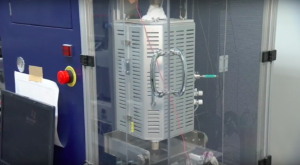SIP “Energy Carriers” video: ammonia turbines, industrial furnaces, fuel cells
By Trevor Brown on October 13, 2017
To demonstrate the progress of the SIP “Energy Carriers” program, the Japan Science and Technology Agency last week released a video, embedded below, that shows three of its ammonia fuel research and development projects in operation.
R&D is often an abstract idea. By contrast, this video shows precisely what it looks like to generate power from ammonia. As it turns out, fuel cells aren’t hugely photogenic. Nonetheless, if a picture is worth a thousand words, this will be a long article.
Utilization for gas turbine power generation

We have written extensively about ammonia turbine combustion in Japan, most recently last week, with the demonstration of a 20% ammonia-natural gas power generation project planned for next year.
For the 2018 demonstration, we’re talking about a 2MW class “multi-fueled gas turbine,” now in development by global engineering firm IHI Corporation.
“We have revealed that ammonia can be used as a fuel, similar to natural gas, using conventional combustion equipment. This is a premixed ammonia / air flame, which is stabilized by a swirl burner. The visual characteristic of the ammonia combustion is an orange flame while the familiar natural gas shows a blue flame. The ammonia flame is stabilized in high speed by using swirl burners, which are used in gas turbines. Because the swirl flame is very stable, a large amount of heat is successfully released using even small burners.”
Prof. Hideaki Kobayashi, Tohoku University, Japan SIP “Energy Carriers” video.
Utilization for industrial furnaces

Two model ammonia combustion furnaces have been installed in Osaka University: one is a 10 kW class and the other is a 100 kW class burner. An important part of this project was the study of how to control NOx emissions, not just by SCR after-treatment but by control of the combustion reactions, to suppress NOx formation in the first place.
“This equipment features the burner of almost the same size as a burner installed in a practical industrial furnace.” By adopting multi-stage combustion and oxygen-enriched combustion, they succeeded in suppressing the concentration of NOx in the exhaust lower than environmental standards in Japan.
Prof. Fumiteru Akamatsu, Osaka University, Japan SIP “Energy Carriers” video.
Utilization for fuel cells

In July 2015, the research team at Kyoto University successfully demonstrated its 200W direct ammonia-fueled SOFC, at the time “the largest scale in the world.”
As we reported again last week, this test has now expanded to a full 1kW fuel cell, although the longevity of the stack test, is perhaps even more significant, with over 1,000 hours of continuous operation.
As with all aspects of the SIP program, the R&D scope includes new materials and parts, and this has been crucial for the fuel cell program. To prevent leaks in the ammonia fuel cell stack, for example, commercial partner Noritake has developed a new glass sealant.
“We’ve been studying direct ammonia-fueled solid oxide fuel cells, SOFC” … Ammonia as a fuel was directly supplied to the stack and a satisfactory level of generation characteristics was attained, almost the same as the fuel cell using hydrogen.
Prof. Koichi Eguchi, Kyoto University, Japan SIP “Energy Carriers” video.